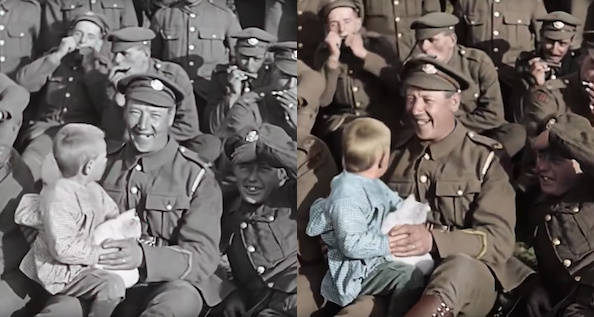They Shall Not Grow Old distills 600 hours of original World War I footage into a 90-minute, colorized experience with the soldiers at the front lines.

YouTubeA result of Peter Jackson’s restoration in They Shall Not Grow Old.
Academy award-winning director and producer Peter Jackson is perhaps best known for his work on The Lord Of The Rings. But his newest project, the World War I documentary They Shall Not Grow Old, will leave a far different legacy.
The documentary has brought hundreds of hours of World War I footage to life via the process of film colorization. Jackson has hailed his latest project “the best gift I could give at the moment.”
About The Film
The footage for the harrowing war documentary, They Shall Not Grow Old, was obtained by Jackson and his team from Britain’s Imperial War Museum and has since been fully restored and colorized in remarkable detail and resolution.
Jackson’s grandfather fought in World War I, and it is to him who They Shall Not Grow Old is dedicated. “I liked doing this movie because it was about the common experience of the soldier,” Jackson explains. “I felt that I was learning about what my grandfather went through.”
Jackson continued in an interview:
“The First World War, for good or for worse, is defined in people’s imaginations by the film that is always used in all the documentaries and it looks bloody awful, for obvious reasons. There were technical limitations and also a hundred years of age – of shrinkage and duplication and starches.”
Jackson hopes to overcome this legacy with his own version of shockingly well-restored film.
The documentary, which is set to premiere on Oct. 16 at the BFI London Film Festival, features 90 minutes of footage sourced from over 600 hours of filmed material. Copies of the film will be sent to every U.K. high school as an educational aid. U.S. release information has not yet been confirmed.
Making They Shall Not Grow Old
The film was created using a fairly new and advanced method of colorization. Modern computerized colorization was invented in 1970 by former NASA engineer Wilson Markle. The first footage that was colorized using Markle’s process was from the original moon landing in 1969.
While Markle’s colorization method required the use of a lot of technology, at its core was a simple process. The original black-and-white films were copied and put into a computer that determined the exact shade of grey of every object in the footage.
Then in the first frame of each scene, a palette of 4,000 shades and hues was used to match each shade of grey with a color. Some colors were assigned using common sense (the sky was assigned a shade of blue, for example), but other color assignments required more research. Production teams sifted through archived production photographs and props to best match objects with their appropriate colors.

FlickrPeter Jackson at San Diego Comic Con in 2014.
This colorization process can cost producers up to $3,000 per minute of film. A 1988 report estimated the cost of colorizing an entire feature film was somewhere around $300,000. However, the average revenue generated from re-releasing a film could be as high $500,000.
Colorizing films, then, seemed a no-brainer to many movie makers. Even though film colorizing was expensive, movie studios actually profited from creating a new movie viewing experience from their existing film catalogs.
But when first introduced, colorization wasn’t well received by everyone in the film industry.
Colorizing already-existing films and re-releasing them for a profit obviously appealed to studio executives, but not so much to filmmakers. Ted Turner of Turner International was particularly interested in this process, as his company owned an extensive catalog of black-and-white films.
Turner said he was considering colorizing Citizen Kane back in 1985. But the firm’s director Orson Welles was on his deathbed at the time, and a few weeks before his death Welles reportedly told a friend, “Don’t let Ted Turner deface my movie with his crayons.”
Throughout the 1980s the practice of film colorization was a widely debated topic. But by the 1990s, the practice wasn’t as much of a controversial issue as it had been in the past.
Colorizing and restoring this footage from WWI serves an overwhelmingly positive purpose for Jackson, who worked for free on this passion project.
Why This Film Is Unprecedented
https://www.youtube.com/watch?v=EHYRfukHToc
Jackson’s team of producers for They Shall Not Grow Old not only masterfully colorized the footage, but also converted it to 3D, slowed down the speed, and added sound, which collectively brought these soldiers to life in a way that hasn’t been done before.
“I wanted to reach through the fog of time and pull these men into the modern world, so they can regain their humanity once more – rather than be seen only as Charlie Chaplin-type figures in the vintage archive film,” Jackson told the BFI.
The results that Jackson’s team were able to manifest were absolutely stunning — they even shocked Jackson himself. “It took me hugely by surprise,” he said. “I had no way of knowing.”
Jackson wanted his restoration efforts to better illustrate what the war looked like, just as the soldiers saw it, for more immersive audience experience. But don’t expect a revelatory history lesson from the documentary.
“You’re not going to learn anything about the First World War from a greater view,” says Jackson, who posits that many soldiers in WWI did not know why they had to be involved or what was so important — politically or otherwise— about beating the Germans.
Instead, They Shall Not Grow Old reveals another more intimate facet of history.
“But you’ll learn how the soldiers felt,” Jackson suggests, “And you might be surprised.”
After this look at They Shall Not Grow Old, check out the true story of the World War I Christmas truce. Then, learn about Cher Ami, the pigeon who saved the lives of 200 men during World War I.





